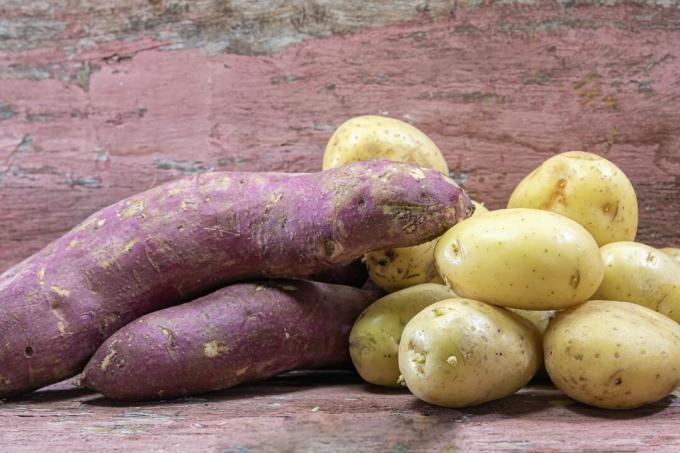Everything about the ingredients of healthy sweet potatoes: calorie values, protein, carbohydrate and iodine content. Everything about suitability for dieters and diabetics.

The sweet potato has long been an exotic item in the vegetable department. In the meantime, however, the sweet potato is available in almost every supermarket. The tuber is best known for its sweet taste and beautiful orange colour. But what else can the sweet potato offer, apart from an apparently quite high sugar content?
sweet potato vs. potato
When comparing potatoes and sweet potatoes, the carbohydrate content, protein content and vitamin C content are of primary interest. All nutritional information here refers to 100 g of the respective tuber with skin. Sweet potatoes contain far more carbohydrates than normal potatoes. With 24 g of carbohydrates, a sweet potato has about 10 g more than the potato. Of the 24 g in the raw sweet potato, only 3 g is sugar, the rest is starch. The really sweet taste only develops when the sweet potato is cooked, because then more starch is converted into sugar. Because of the higher starch and sugar content, a sweet potato naturally also has more calories.
- Sweet potato: 117 kcal, 2 BE
- Potatoes: 73, 1.2 BE
Potatoes are therefore more suitable for a diet in which you want to consciously avoid large amounts of carbohydrates. Nevertheless, the sweet potato is not a calorie bomb and due to the numerous other healthy ingredients it is anything but unhealthy. The protein content of the sweet potato is slightly lower than that of the regular potato.
- Sweet potato: 1.6 g protein
- Potatoes: 2 g protein
When it comes to protein mass, both tubers are not the most optimal foods. However, when it comes to protein intake, the quality is much more important. Both tubers supply our body with essential amino acids and sweet potatoes and potatoes are therefore important for a good protein supply, especially for vegetarians and vegans. Nevertheless, the point here goes to the potato, as it contains fewer calories and can therefore be eaten in larger quantities.

In terms of vitamin C content, however, the sweet potato wins in any case. At around 30 mg, their content is almost twice as high as that of the potato (17 mg). During preparation, ingredients such as vitamin C are preserved if the sweet potato is cooked whole and with the skin on. In addition, the sweet potato is also a perfect supplier of beta-carotene. The tubers can contain up to 8.5 mg of it. For comparison, even a carrot only has 9.5 mg of the healthy ingredient to offer. In addition, the sweet potato lacks the toxic alkaloid solanine, which occurs in the potato skin and which cannot be destroyed by cooking. Other noteworthy ingredients of the sweet potato at a glance:
- Fat: 0.6g
- Dietary fiber: 3 g
- Minerals: 1.12 g (especially potassium, iron and phosphorus)
- Vitamin B2: 0.1 mg
- Low in histamine
- Very high oxalic acid content
The oxalic acid content is not problematic for occasional consumption and in a healthy person. For example, spinach contains twice as much oxalic acid as sweet potatoes. Information about the sweet potato in connection with iodine is also often sought. It's not so much about the iodine content, but rather about a substance in the sweet potato that is said to disrupt the iodine metabolism. However, this problem does not affect healthy people without an underactive thyroid.

sweet potato and diabetes
The sweet potato is said to be particularly suitable for diabetics. The ingredient Caiapo is responsible for this. This substance, which is particularly found in the skin of sweet potatoes, has been shown to increase sensitivity to insulin. The ingredient is supposed to help with type 2 diabetes in particular. Some websites are already talking about a new miracle cure. However, in one study, a fixed amount of Caiapo was administered daily for five months. It is questionable whether this amount can also be ingested with a normal diet. Because most of the time the skin of the sweet potato is not eaten and the question remains whether Caiapo is still intact after cooking. Whether the sweet potato is particularly helpful in diabetes cannot yet be answered in a well-founded manner.
If you now feel like planting the delicious vegetables in your own garden, you will find our best ones here Sweet potato growing tips.



